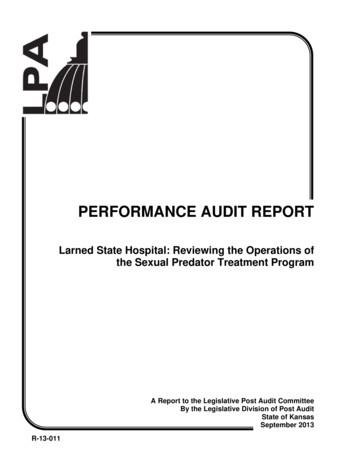
Transcription
PERFORMANCE AUDIT REPORTLarned State Hospital: Reviewing the Operations ofthe Sexual Predator Treatment ProgramA Report to the Legislative Post Audit CommitteeBy the Legislative Division of Post AuditState of KansasSeptember 2013R-13-011
Legislative Division of Post AuditThe Legislative Division of Post Audit is the auditarm of the Kansas Legislature. Created in 1971,the division’s mission is to conduct audits thatprovide the Legislature with accurate, unbiasedinformation on the performance of state and localgovernment. The division’s audits typically examinewhether agencies and programs are effective incarrying out their duties, efficient with theirresources, or in compliance with relevant laws,regulations and other requirements.The division’s audits are performed at the directionof the Legislative Post Audit Committee, abipartisan committee comprising five senators andfive representatives. By law, individual legislators,legislative committees, or the Governor mayrequest a performance audit, but the LegislativePost Audit Committee determines which audits willbe conducted.Although the Legislative Post Audit Committeedetermines the areas of government that will beaudited, the audits themselves are conductedindependently by the division’s professional staff.The division’s reports are issued without any inputfrom the committee or other legislators. As a result,the findings, conclusions, and recommendationsincluded in the division’s audits do not necessarilyreflect the views of the Legislative Post AuditCommittee or any of its members.The division conducts its audit work in accordancewith applicable government auditing standards setforth by the U.S. Government Accountability Office.These standards pertain to the auditor’sprofessional qualifications, the quality of theaudit, and the characteristics of professionaland meaningful reports. The standards alsohave been endorsed by the AmericanInstitute of Certified Public Accountants(AICPA) and adopted by the Legislative PostAudit Committee.LEGISLATIVE POST AUDIT COMMITTEERepresentative Peggy Mast, ChairRepresentative John BarkerRepresentative Tom BurroughsRepresentative Virgil Peck, Jr.Representative Ed TrimmerSenator Jeff Longbine, Vice-ChairSenator Anthony HensleySenator Laura KellySenator Julia LynnSenator Michael O’DonnellLEGISLATIVE DIVISION OF POST AUDIT800 SW JacksonSuite 1200Topeka, Kansas 66612-2212Telephone: (785) 296-3792Fax: (785) 296-4482Website: http://www.kslpa.orgScott Frank, Legislative Post AuditorHOW DO I REQUEST AN AUDIT?By law, individual legislators, legislative committees, or the Governor may request an audit, butany audit work conducted by the division must be directed by the Legislative Post AuditCommittee. Any legislator who would like to request an audit should contact the division directlyat (785) 296-3792.The Legislative Division of Post Audit supports full access to the services of state government for all citizens. Uponrequest, the division can provide its audit reports in an appropriate alternative format to accommodate persons withvisual impairments. Persons with hearing or speech disabilities may reach the division through the Kansas RelayCenter at 1-800-766-3777. The division’s office hours are 8:00 a.m. to 5:00 p.m., Monday through Friday.
This audit was conducted by Dan Bryan, Brad Hoff, and Joe Lawhon. Chris Clarke wasthe audit manager. If you need any additional information about the audit’s findings,please contact Dan Bryan at the Division’s offices.Legislative Division of Post Audit800 SW Jackson Street, Suite 1200Topeka, Kansas 66612(785) 296-3792Website: www.kslpa.org
Table of ContentsIs the Sexual Predator Treatment Program Appropriately Managed To Ensure the Safety and WellBeing of Program Staff and Offenders?We Identified a Few Safety and Security Issues That Could Affect Staff and Resident Safety . 9The Sexual Predator Treatment Program Did Not Have Adequate Policies or Controls to Ensure Keys andDoors Were Secure . 11Security Controls to Prevent and Detect Prohibited Items Were Inadequate . 13Despite Participating in Conflict Avoidance Training, Some Staff Did Not Feel AdequatelyPrepared for Resident Altercations . 15A Significant Number of Direct Care Staff Positions Were Vacant . 17Program Staff Worked a Significant Amount of Overtime to Provide Safety, Security, and Treatment. 18Even with Significant Overtime, the Program Often Failed to Meet its Internal Minimum StaffingGoals . 20Conclusion . 22Recommendations . 22List of FiguresFigure OV-1: Selected Demographic Information for Sexual Predator Treatment Program Residents(As of April 1, 2013). 6Figure OV-2: Estimated Growth of Larned State Hospital’s Sexual Predator Population Compared toPhysical Capacity . 7Figure 1-1: Two Residents Face Federal Charges in Different Cases . 15Figure 1-2: Total Overtime Hours Worked by Sexual Predator Treatment Program Staff . 19Figure 1-3: Comparison of Program Staffing Goals to Reported Staffing Levels for Selected Days(January 2013 – May 2013) . 21List of AppendicesAppendix A: Scope Statement. 25Appendix B: Agency Response . 27
Larned State Hospital: Reviewing the Operations of theSexual Predator Treatment ProgramKansas’ Sexual Predator Treatment Program was established in1994, and has been provided primarily through the Larned StateHospital. The program provides treatment for convicted sexoffenders who have completed their prison sentences but havebeen determined by the courts to be violent sexual offenders inneed of involuntary inpatient treatment.In 2005, Legislative Post Audit issued a report on the SexualPredator Treatment Program. In that report, we estimated the sizeof the offender population could increase to about 235 offenders ormore by 2015. The reasons for this included the continuingcommitment of new offenders to the program and Kansas’stringent requirement that the risk of a re-offense be reduced to“practically nil” before an offender would be released from theprogram.As of April 2013, the program had 226 residents, with 219residents at Larned State Hospital and seven residents atOsawatomie State Hospital. Agency officials estimate that, in thecoming years, the program will grow by about 18 offenders peryear.Legislators have expressed concern about whether the Larnedfacility is being adequately managed.This performance audit answers the following question:Is the Sexual Predator Treatment Program appropriatelymanaged to ensure the safety and well being of program staffand offenders?A copy of the scope statement the Legislative Post AuditCommittee approved for this audit is included in Appendix A onpage 24. In May 2013, the Legislative Post Audit Committeedecided to delay audit work on questions one and two and awaitthe written report of a Department for Aging and DisabilityServices’ task force. The mission of this task force is to answerquestions very similar to questions one and two of the scopestatement. As a result, this audit report includes only questionthree from the approved scope statement.PERFORMANCE AUDIT REPORTLarned State Hospital: Review of theSexual Predator Treatment Program (R-13-011)1Legislative Division of Post AuditSeptember 2013
To answer the audit question, we performed a variety of tasks. Wereviewed program policies and procedures, as well as incidentreports, resident grievance reports, and surveillance video. Wealso reviewed safety and security reports from the KansasDepartment of Health and Environment and The JointCommission—the federal entity responsible for accrediting LarnedState Hospital. We analyzed various program data concerningstaffing and overtime hours worked. In addition, we interviewedprogram officials and conducted onsite tests of safety and securitycontrols.We also surveyed Sexual Predator Treatment Program staff abouta variety of issues related to safety and security. Of the 170surveys sent, 46 were returned for a response rate of 27%. Asummary of the Sexual Predator Treatment Program surveyresponses is available upon request.We conducted this performance audit in accordance with generallyaccepted government auditing standards. Those standards requirethat we plan and perform the audit to obtain sufficient, appropriateevidence to provide a reasonable basis for our findings andconclusions based on our audit objectives. We believe theevidence obtained provides a reasonable basis for our findings andconclusions based on our audit objectives.Data related to the number of staff working each shift weresomewhat inconsistent due to staff entering data in different ways.Therefore, we focused our staffing analysis on summary level data.We do not think inconsistencies in the detailed data significantlyaffected our audit findings.Some of our findings are based on a review of a sample of staffincident reports and resident grievances. These findings are notprojectable to the program as a whole.Our findings begin on page 9 following a brief overview ofKansas’ Sexual Predator Treatment Program.PERFORMANCE AUDIT REPORTLarned State Hospital: Review of theSexual Predator Treatment Program (R-13-011)2Legislative Division of Post AuditSeptember 2013
Overview of the Sexual Predator Treatment ProgramIn 1994, the LegislatureCreated a CivilCommitment Program forSex Offenders Through theSexually Violent PredatorActThe 1993 rape and murder of a Pittsburg State University studentby a sex offender, who had been released from prison about sevenmonths earlier, prompted the Legislature to act. Through the1994 Sexually Violent Predator Act, the Legislature created aseparate civil commitment for the long-term control, care, andtreatment of sexual predators.Civil commitment is an involuntary confinement in a securefacility. Kansas’ Sexual Predator Treatment program facilitiesare not considered prisons but are secured through locked doors,perimeter fencing, and security staff. The rights of committedindividuals are restricted including confinement to their assignedresidential units, controlled movement to and from treatment, andno access to the Internet. Civil commitment is intended to keepthese individuals confined for treatment.District courts determine whether convicted sex offendersshould be civilly committed to the Sexual Predator TreatmentProgram after the completion of their prison sentence. Uponrelease from prison, a court must determine that a sex offenderhas a mental abnormality or personality disorder that will makethat person likely to engage in repeat acts of sexual violence if nottreated. The commitment process is multi-staged and rigorous.The process includes an evaluation by multi-disciplinary teamsand Larned State Hospital professionals, a review by the AttorneyGeneral and a judge, and a trial to determine beyond a reasonabledoubt that the offender is a sexual predator. On average only 18of the 300 sexual offenders released from prison every year arecommitted to the Sexual Predator Treatment Program. After theyare committed, sex offenders remain in the program until theirabnormality or disorder has changed and they are deemed “safe”to be allowed to return to society.The goal of the treatment program is to eliminate thelikelihood that sex offenders will re-offend after their release.Kansas has set a very high standard for release from the program.The statutorily mandated goal of the program is to have no newvictims. To be released from the program, a resident has to completeseven treatment phases. Each phase consists of differentobjectives that must be reached before a resident advances to thenext phase. For example, a resident must complete a relapseprevention plan. Phases 1 through 5 are provided at Larned StateHospital, while the last two phases—known as transition—areprovided at Osawatomie State Hospital. Residents who completeall seven phases are conditionally released from the program.PERFORMANCE AUDIT REPORTLarned State Hospital: Review of theSexual Predator Treatment Program (R-13-011)3Legislative Division of Post AuditSeptember 2013
District courts monitor residents who are conditionally released fromthe program for at least five years. After that period, a resident iseligible for final discharge by the court from the program. Those who do not participate in treatment will not be released.Although admission to the program is involuntary, participation inthe program is voluntary. In other words, residents can opt out oftreatment. However, residents who decline treatment remainconfined to the facility indefinitely.In 1997, the U.S. Supreme Court ruled Kansas’ SexuallyViolent Predator Act was constitutional. In Kansas vHendricks, the Court ruled the civil commitment process was nota second prosecution for the same crime and did not violate anoffender’s due process rights. Since the Court’s ruling, manyother states including Iowa, Missouri, and Nebraska have enactedsimilar civil commitment programs. In all, 20 states have suchprograms.Most Civilly CommittedSexual Predators in KansasReside and ReceiveTreatment at Larned StateHospitalAfter the court determines an individual to be a sexual predator,the individual is committed to the Sexual Predator TreatmentProgram. This program primarily operates at Larned StateHospital, with some functions at Osawatomie State Hospital.Program residents reside in a secure facility and haverestricted interaction with society. Residents are confined toone of several buildings on the Larned State Hospital groundswhich have barbed-wire fences surrounding their perimeter. Alldoors accessing exterior areas are locked, and all interior doorsshould also be closed and locked. Generally, residents should beescorted by staff when they move within the facility. If a residentneeds to leave the Larned State Hospital grounds, for example fora doctor appointment, at least two staff members accompany theresident whose hands and feet are restricted.Residents have restricted access to telephones, televisions,computers, and visitors. Examples of restrictions include: The residents can only use phones located in a common area.All outgoing phone calls must be collect calls or made using aprepaid phone card. Program staff monitor all television viewing in the common areaand have the discretion to change the channel. Additionally,some residents have televisions with limited channel access intheir private rooms. Computers do not have access to the Internet. Instead, theycan be used to conduct legal research and to work on treatmentassignments.PERFORMANCE AUDIT REPORTLarned State Hospital: Review of theSexual Predator Treatment Program (R-13-011)4Legislative Division of Post AuditSeptember 2013
Visitors are searched and visitations are monitored by staff.Residents are allowed to meet with visitors on weekends andholidays, but only during specified times. Program staff mustapprove all visitors. Upon arrival at the facility, security staff arerequired to screen each visitor. Visitors are not allowed toexchange items with residents during the visit. Additionally,program staff are required to remain in the visitation room tomonitor all interactions.The Sexual PredatorTreatment Program’sResident Population HasGrown Steadily Since ItsInceptionThe first sex offender was committed to the program in October1994. In 1997, after the U.S. Supreme Court ruled Kansas’ lawwas constitutional, the program began to grow rapidly and hascontinued to do so.From 2002 to 2012, the program added an average of about18 residents each year. Over that time period, the program hasadmitted between 12 and 29 residents every year. As of April2013, the program had 226 residents, with 219 residents at LarnedState Hospital and seven residents at Osawatomie State Hospital.The program is authorized about 300 full-time equivalent staff toprovide 24 hour-a-day safety, security, and treatment to residents.Although the program is not restricted to males, all residentsadmitted to date have been male. Figure OV-1 on page 6summarizes residents’ age, treatment phase, and the number ofyears in the program as of April 2013. As the figure shows amajority of the program’s residents are in their 40s or 50s. Thefigure also shows that most residents are in phase two and three oftreatment and the majority have been in the program more thanfive years. Additionally, about 80% of the residents have beendiagnosed as pedophiles. Other common diagnoses includeschizophrenia, bipolar disorder, and depression.Based on the average growth rate, the program will reach itscurrent maximum physical capacity during 2018. Theprogram admits about 18 new residents each year and has acurrent capacity at Larned State Hospital of 293 residents. Thecurrent physical capacity and program growth rate are shown inFigure OV-2 on page 7. As the figure shows, the program willreach its physical capacity in fiscal year 2018.Because so few residents are released, program enrollment islikely to grow well beyond the physical capacity at LarnedState Hospital. Since the program began, only three residentshave completed the program and 22 have died. Based onassumptions about death rates and program completion rates, weestimate the program could grow to about 500 residents within thenext 20 years as shown in Figure OV-2.PERFORMANCE AUDIT REPORTLarned State Hospital: Review of theSexual Predator Treatment Program (R-13-011)5Legislative Division of Post AuditSeptember 2013
Number of ResidentsFigure OV-1Selected Demographic Information forSexual Predator Treatment Program Residents(As of April 1, 2013)Age of Residents80736860514140207020-29 years30-39 years40-49 years50-59 years60 years andolderProgram PhaseNumber of Residents10089738060402024141914520(a) Located at Ossawatomie State HospitalNumber of Years at Sexual Predator Treatment ProgramNumber of Residents1008091737260402040 5 years5 to 10 years10 to 15 years 15 or more yearsSource: Sexual Predator Treatment Program (unaudited).PERFORMANCE AUDIT REPORTLarned State Hospital: Review of theSexual Predator Treatment Program (R-13-011)6Legislative Division of Post AuditSeptember 2013
Figure OV-2Estimated Growth of Larned State Hospital'sSexual Predator Population Compared to Physical Capacity (a)600499Resident Population500400Program's PhysicalCapacity(293 282033(a) To estimate the future growth of the program’s resident population we considered certain factors such as the age of the residents alreadycommitted to the program, the number of individuals who have been committed to the program in recent years, and the number of individualswho have successfully completed and been released from the program.Source: LPA analysis of SPTP records and LPA assumptions about future commitments, releases, and resident deaths.PERFORMANCE AUDIT REPORTLarned State Hospital: Review of theSexual Predator Treatment Program (R-13-011)7Legislative Division of Post AuditSeptember 2013
PERFORMANCE AUDIT REPORTLarned State Hospital: Review of theSexual Predator Treatment Program (R-13-011)8Legislative Division of Post AuditSeptember 2013
Is the Sexual Predator Treatment ProgramAppropriately Managed to Ensure the Safety and Well Being ofProgram Staff and Offenders?Answer in Brief:Overall the Sexual Predator Treatment Program appears to havedone a good job of addressing staff and resident safety and security,though we did identify a few safety and security issues that couldaffect staff and resident safety (p. 9). Specifically, the program didnot have adequate policies or controls to ensure keys and doorswere secure (p. 11) and to prevent and detect residents receivingprohibited items (p. 13). Also, despite participating in conflictavoidance training, some staff did not feel adequately prepared forresident altercations (p. 15).In addition, a significant number of staff positions responsible forensuring safety, security, and treatment of residents were vacant(p. 17) and program staff worked a significant amount of overtime(p. 18). Finally, even with significant amounts of overtime, theprogram consistently failed to meet its internal minimum staffinglevels needed to provide safety, security, and treatment (p. 20).These and other findings are discussed in the sections that follow.FINDINGS RELATED TO SPECIFIC SECURITY ISSUESWe Identified a FewSafety and SecurityIssues That CouldAffect Staff andResident SafetyThe Sexual Predator Treatment Program (program) providestreatment for convicted sex offenders who have completed theirprison sentences but who have been determined by the courts to besexual predators. Because most residents’ underlying crimes wereviolent sexual offenses, it is important for the program to ensure thesafety and security of both residents and staff.At the start of this audit we were not aware of any specific concernsabout the safety and security of program staff and residents.Therefore, we selected five areas to review based on their level ofrisk and importance regarding the operation of a secure facility, andwe surveyed staff to identify any areas of concern they had. Todetermine whether program officials have taken adequate steps toensure the safety of residents and staff, we spoke with programofficials, reviewed facility policies and procedures, observed dailystaff activities, and reviewed incident reports, resident grievances,and surveillance video.Survey respondents expressed concerns about workplace safety,policies not being followed, and safety not being a managementpriority. In all, we surveyed 170 program staff members with aresponse rate of 27%. Of the 46 survey respondents:PERFORMANCE AUDIT REPORTLarned State Hospital: Review of theSexual Predator Treatment Program (R-13-011)9Legislative Division of Post AuditSeptember 2013
Only half of survey respondents felt safe while working. About22% of staff responded feeling unsafe at work and the rest wereneutral. These results are not surprising, given the violent history ofmany of the program’s residents. Only half of survey respondents felt residents were living in asafe and secure environment. About 20% of staff responded thatresidents were not safe and secure, and the remaining responseswere neutral. Many survey respondents reported both management and staffdo not follow safety and security policies. About 35% of surveyrespondents reported that management does not consistently enforcesafety and security policies. Similarly, about 45% reported programstaff do not consistently follow safety and security policies. Surveyrespondents cited doors being propped open and staff cell phonesbeing brought into the facility. About 40% of survey respondents reported safety and securitywas not a high priority for management. Similarly, about 25%reported it was not a high priority for non-management staff.We examined safety and security policies and practices in fiveareas and identified three areas that needed improvement. As acivil confinement facility, we expected the program to have strongcontrols regarding securing doors and keys, controlling prohibiteditems, staff training, monitoring resident movement, andinvestigating incidents and complaints. The problems we identifiedin three of these areas are summarized below. Controls over facility doors and keys need to be strengthened.Program management could increase the facility’s safety and securityby prohibiting staff from taking keys offsite and clearly articulating inpolicy that all doors are to be kept locked at all times. (More detail canbe found starting on page 11.) Controls preventing residents from obtaining prohibited itemsneed to be improved. The risk of residents receiving prohibited itemssuch as cell phones and pornography could be decreased if securityofficers provided better scrutiny of program staff as they entered theprogram’s residential units and facilities, more closely inspected allincoming packages, and increased the usage of electronic screeningdevices. (More detail can be found starting on page 13.) Staff training regarding physical and verbal altercations needs tobe improved. Upon hiring and every year thereafter, program staffreceive training about how to handle physical and verbal altercationsinvolving residents. Larned State Hospital provides training using anationally recognized program. However, several survey respondentsreported they feel the training was not adequate for addressingphysical altercations. Program management could improve training byactively seeking staff feedback. (More detail can be found starting onpage 15.)PERFORMANCE AUDIT REPORTLarned State Hospital: Review of theSexual Predator Treatment Program (R-13-011)10Legislative Division of Post AuditSeptember 2013
The other two safety and security areas that we examined appearedto be managed appropriately. These two areas are summarizedbelow. Staff appear to appropriately monitor resident location andmovement. Program policy requires all residents be observed andcounted every 30 minutes—and in some cases certain residentsreceive closer scrutiny. Also, program staff are required to escortresidents to most places within the facility and when residents leavethe facility. Survey respondents expressed very few concernsregarding how program staff account for residents and supervise theirmovement. Staff appear to investigate incidents and complaintsappropriately. The program has developed a formalized process toreview and investigate staff incident reports and resident grievances.We reviewed a total of 22 staff incident reports and residentgrievances and determined that officials followed the standard processin all occasions and investigations seemed complete. We alsodetermined that for each situation the final decision made by programofficials was reasonable. In a few instances the special investigatorrecommended the county attorney press charges against residentsbecause of their actions.The Sexual PredatorTreatment ProgramDid Not HaveAdequate Policies orControls to EnsureKeys and DoorsWere SecureSecure facilities should have strong controls over keys and doors.In general, doors are kept locked to prevent escapes and decreasethe risk of other security breaches. Similarly, key control isimportant to ensure that staff can access certain areas and carry onlythe keys that are necessary for their job duties. It is important toprohibit staff from taking their keys offsite, because those keyscould be lost or stolen.The program operates under the premise that all facility doors—both exterior and interior—should be kept locked at all times. Theprogram also operates with two classifications for its keys, asexplained below. Assigned staff keys—these keys are specifically assigned to anindividual employee. In general, these keys primarily lock and unlockinterior doors to hallways, resident living units, classrooms, treatmentareas, etc. Facility keys—these keys are not assigned to any one individual.Instead, they are kept in locked boxes (referred to as key arsenals)strategically placed throughout the program buildings and otherLarned State Hospital buildings. Keys kept in each arsenal arechecked out by staff as needed. In general, they are used to unlockoutside entry doors and gates and can be used to unlock other doorsin emergency situations.We identified several problems regarding the program’s controlsover keys and doors, as explained on the next page.PERFORMANCE AUDIT REPORTLarned State Hospital: Review of theSexual Predator Treatment Program (R-13-011)11Legislative Division of Post AuditSeptember 2013
Some staff were allowed to take assigned keys offsite, whichincreases the risk that facility keys could be lost or stolen,thereby compromising the facility’s physical security. As ofMay 2013, the Larned State Hospital (which includes the SexualPredator Treatment Program) had about 8,000 keys assigned tohospital staff. Neither the Larned State Hospital nor the programhad a policy which prohibits staff from taking their assigned keysoffsite. Program officials reported that some staff were allowed totake their keys off hospital grounds during lunch or at the end ofshifts. Additionally, we observed some staff arriving for workwithout stopping at the security desk to retrieve their keys. Programofficials acknowledge that taking keys offsite is a problem but havenot addressed the issue yet. Sexual Predator Treatment Programofficials are currently developing a new key control policy whichcategorizes keys and low risk or high risk. Per the new draft policy,the low risk keys can be taken offsite, while the high risk keyscannot.Program manageme
separate civil commitment for the long-term control, care, and treatment of sexual predators. Civil commitment is an involuntary confinement in a secure facility. Kansas' Sexual Predator Treatment program facilities are not considered prisons but are secured through locked doors, perimeter fencing, and security staff. The rights of committed











